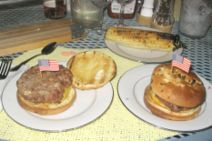Hamburger: Difference between revisions
imported>Howard C. Berkowitz No edit summary |
imported>Hayford Peirce (→Standardized fast food: removed a paragraph of blatant BS) |
||
| Line 17: | Line 17: | ||
The hamburger played an important role in America’s transformation into a mobile, suburban culture, and in the 21st century, despite strong competition from pizza and tacos, it remains America’s favorite sandwich. | The hamburger played an important role in America’s transformation into a mobile, suburban culture, and in the 21st century, despite strong competition from pizza and tacos, it remains America’s favorite sandwich. | ||
Along with [[Coca-Cola]], the hamburger was once disdainfully regarded by many non-Americans as the epitome of low cultural taste. With the advent of mass marketing from imitators of McDonald's such as Burger King, however, hamburgers have now spread around the world and, with variations, are consumed in every culture. Indeed the ''Economist'' magazine uses the price of a Big Mac to compare the price levels of different economies because it is the single most nearly standardized product in most countries around the globe. | Along with [[Coca-Cola]], the hamburger was once disdainfully regarded by many non-Americans as the epitome of low cultural taste. With the advent of mass marketing from imitators of McDonald's such as Burger King, however, hamburgers have now spread around the world and, with variations, are consumed in every culture. Indeed the ''Economist'' magazine uses the price of a Big Mac to compare the price levels of different economies because it is the single most nearly standardized product in most countries around the globe. | ||
Revision as of 23:17, 20 May 2009
A hamburger (or hamburg or burger) is a sandwich made with a bun containing a patty of ground, cooked meat that is almost always beef, usually served with condiments such as relish, mustard, or ketchup. The bun is usually but not always toasted or otherwise warmed.
Most authorities consider that the word "hamburger" is derived from the German city of Hamburg, which once enjoyed prosperous commerce with the Baltic Provinces in Russia, where shredded raw meat (we now know it as steak tartare) was popular. [1] Around 1900, a popular meal in the United States was "Salisbury steak," cooked, ground steak, which was promoted by a food faddist named Dr. J. H. Salisbury as a cure for innumerable ailments. At some point in the late 19th or early 20th century hamburgers as we know them, cooked patties within a roll, made their first appearance in the United States, although exactly where and when is still debated.
Generally considered to be an informal meal or a convenience food, its meat can be grilled, fried, broiled, microwaved, or steamed. One of its most popular variations, a hamburger served with melted cheese on top, is called a cheeseburger.
Variations
Many cultures over the centuries have cooked finely chopped or ground meats in shapes such as meatballs, patties, or steaks, often flavored with other ingredients. The Larousse Gastronomique, for instance, gives a half-dozen Hungarian, German, and Austrian recipes for what it calls Keftedes, all translated as variations on "hamburgers". [2]
Standardized fast food
Tens of thousands of diners and restaurants in the U.S. serve their own version of the hamburger. Standardization was invented by Walter Anderson, who in 1921 opened the first of a nationwide chain of White Castle fast food outlets. Anderson trained his staff to cook and serve in exactly the same way, cooking dozens of pre-weighed, pre-shaped burgers at once on a dedicated griddle, and serving them on specially designed buns. Ray Kroc (1902-1984) in 1954 bought a California "drive-in burger bar" from Richard and Maurice McDonald. Kroc standardized his product.
Customers have limited choices at McDonald's, but are ideally supposed to be served in less than 90 seconds. McDonald's closest competitor, Burger King, tries to differentiate itself by advertising that customers are allowed to specify their condiments, with the well-publicized motto "have it your way". McDonald's, however, allows its customers to do the same, although it does not advertise it.
The hamburger played an important role in America’s transformation into a mobile, suburban culture, and in the 21st century, despite strong competition from pizza and tacos, it remains America’s favorite sandwich.
Along with Coca-Cola, the hamburger was once disdainfully regarded by many non-Americans as the epitome of low cultural taste. With the advent of mass marketing from imitators of McDonald's such as Burger King, however, hamburgers have now spread around the world and, with variations, are consumed in every culture. Indeed the Economist magazine uses the price of a Big Mac to compare the price levels of different economies because it is the single most nearly standardized product in most countries around the globe.
